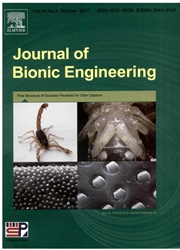

 中文摘要:
中文摘要:
MEMS(micro electro mechanical systems) inertial navigation system(MINS) has been wildly used in robots for its low-cost.The MINS and magnetometers are commonly the component parts of the attitude and heading reference systems(AHRS),which provide pitch and roll angles relative to the earth gravity vector,and heading angle relative to the north.However,the performance of sensors with low cost AHRS is not so good.The gyros are not sensitive enough to observe the earth angular velocity,so the traditional technique like alignment algorithm is invalid.The measurements of gyros become useless to determine the initial attitude matrix from navigation frame to body frame.The alignment algorithm is computed by the accelerometers and magnetometers.The process is established as an optimization problem of finding the maximum eigenvector.Meanwhile the sensitive analysis with respect to the biases of accelerometers is proposed.Then the recursive least squares algorithm(RLSA) is introduced.The comparison between the proposed method and RLSA is provided.The results demonstrate its accuracy favorably and verify the feasibility of the proposed algorithm.
 英文摘要:
英文摘要:
MEMS (micro electro mechanical systems) inertial navigation system ~, Mll'~3) nas Been WllUly used in robots for its low-cost. The MINS and magnetometers are commonly the component parts of the attitude and heading reference systems (AHRS), which provide pitch and roll angles relative to the earth gravity vector, and heading angle relative to the north. However, the performance of sen- sors with low cost AHRS is not so good. The gyros are not sensitive enough to observe the earth an- gular velocity, so the traditional technique like alignment algorithm is invalid. The measurements of gyros become useless to determine the initial attitude matrix from navigation frame to body frame. The alignment algorithm is computed by the accelerometers and magnetometers. The process is es- tablished as an optimization problem of finding the maximum eigenvector. Meanwhile the sensitive analysis with respect to the biases of accelerometers is proposed. Then the recursive least squares al- gorithm (RLSA) is introduced. The comparison between the proposed method and RLSA is provid- ed. The results demonstrate its accuracy favorably and verify the feasibility of the proposed algo- rithm.
 同期刊论文项目
同期刊论文项目
 同项目期刊论文
同项目期刊论文
 A linear domain system identification for small unmanned aerial rotorcraft based on adaptive genetic
A linear domain system identification for small unmanned aerial rotorcraft based on adaptive genetic The model identification for small unmanned aerial rotorcraft based on adaptive ant colony algorithm
The model identification for small unmanned aerial rotorcraft based on adaptive ant colony algorithm 期刊信息
期刊信息
